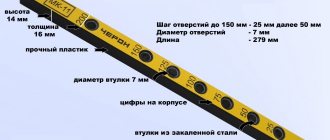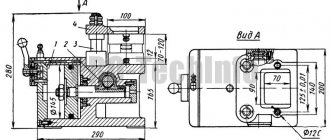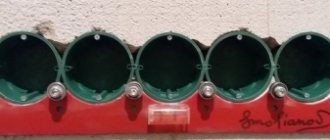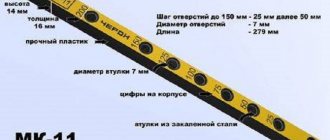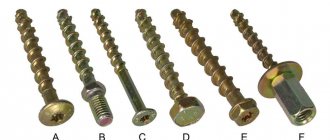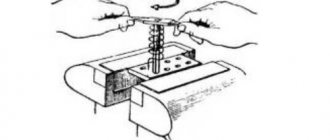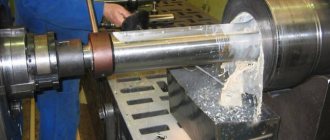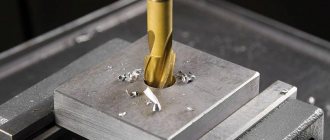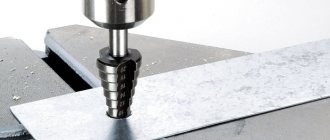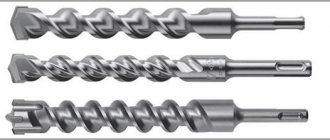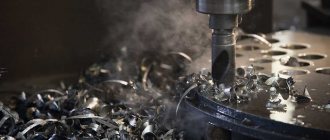Types of drilling on lathes
Conventionally, there are three types of process of drilling holes on a lathe according to the degree of human intervention:
- Manual. This method involves feeding the cutting tool into the cutting zone using a tailstock flywheel driven by human muscle power.
- Mechanical. With this method of processing holes, the drill is fed using a mechanical feed coming from the caliper carriage to the tailstock through a special device. Not all lathes have such devices and, accordingly, the ability to carry out mechanical drilling.
- Using CNC. Full automation of product processing is possible on CNC machines. On a CNC lathe, you can make holes using various methods and tools without human intervention.
Drilling holes
To perform operations for drilling holes with a diameter greater than 25 mm, drilling is carried out in 2 stages. The first step is to drill a hole with a cutting tool of a smaller diameter, and then with a drill of the diameter required for this hole.
It should be taken into account that the diameter of the smaller hole should be selected so that it is approximately equal to the length of the cutting edge of the 2nd drill. This value is selected in order to significantly reduce the cutting force when machining a part with a cutting tool of larger diameter.
For this operation, the cutting tool is selected taking into account the minimum hole diameter. It is worth remembering that only those holes that were obtained through preliminary drilling are subject to drilling.
It is extremely undesirable to carry out drilling in cases where the holes were obtained by stamping and other methods, since this is a high probability of the drill coming out. Otherwise, the rules and safety precautions for drilling coincide with the rules and safety precautions for drilling holes.
The process of drilling and reaming holes on lathes
To create new holes in a workpiece or change the size of old ones, the following types of operations must be performed on a lathe:
- Align the tailstock so that the quill axis coincides with the spindle axis.
- Secure the workpiece in the headstock chuck so that it protrudes beyond the level of the jaws as little as possible.
- Install the cutting tool in the tailstock quill. If you have to change it frequently, it is better to use a quick-change chuck and a set of special bushings. This will help to significantly reduce the time required to change tools. When using a quick-change chuck, all drills, countersinks, reamers, etc. must have shanks with the same Morse taper number. At the beginning of drilling, the quill should be pulled out from the tailstock to the shortest possible distance.
- The first work operation is preparing the end of the workpiece. It should be smooth. This is done by trimming the end with a cutter.
- Make a small recess at the end of the part. This operation will help you drill exactly at the rotation point of the workpiece. This recess is made with a persistent cutter or a short drill.
- Drill using the tailstock flywheel. Feed the tool smoothly. Periodically move it out of the cutting zone to free it from chips. Cool the cutting zone using a special emulsion.
- When through-cutting, you need to reduce the feed speed at the exit from the workpiece so as not to damage it when the load on the cutting edges increases sharply.
- To increase the diameter of the holes, you need to: install a drill of a larger diameter and drill; apply a countersink - carry out countersinking; use a boring cutter to make boring.
- To reduce roughness, reaming is used (the process is reaming).
- To work with edges, use a countersink (the process is countersinking).
[Show slideshow]
When processing cast iron, small chips are formed, which, during liquid cooling, clog the channels for its removal. Therefore, the emulsion cannot be used in such cases.
Video of drilling a hex hole on a lathe
All of the above processes can be performed not only in a labor-intensive manual way, but also by taking advantage of the possibility of connecting a mechanical feed to the tailstock or using CNC. If the cutting processes are carried out using CNC lathes, then the entire tool is attached at the very beginning of the preparatory process in special devices that change automatically in a certain sequence.
Hole making: types of operations and tools used
Hole processing is a whole series of technological operations, the purpose of which is to bring the geometric parameters, as well as the degree of roughness of the inner surface of pre-made holes, to the required values. The holes that are processed using such technological operations can be previously obtained in solid material not only by drilling, but also by casting, punching and other methods.
Processing a drilled hole with a cylindrical countersink
The specific method and tool for processing holes are selected in accordance with the characteristics of the desired result. There are three methods for processing holes - drilling, reaming and countersinking. In turn, these methods are divided into additional technological operations, which include drilling, counterboring and countersinking.
To understand the features of each of the above methods, it is worth considering them in more detail.
Drilling
To process holes, they must first be obtained, for which various technologies can be used. The most common of these technologies is drilling, performed using a cutting tool called a drill.
Main parts of a twist drill
Using drills installed in special devices or equipment, both through and blind holes can be produced in solid material. Depending on the devices and equipment used, drilling can be:
- manual, performed using mechanical drilling devices or electric and pneumatic drills;
- machine tools, carried out using specialized drilling equipment.
The physics of drilling holes
The use of manual drilling devices is advisable in cases where holes, the diameter of which does not exceed 12 mm, need to be obtained in workpieces made of materials of small and medium hardness. Such materials include, in particular:
- structural steels;
- non-ferrous metals and alloys;
- alloys made of polymer materials.
If it is necessary to make a hole of a larger diameter in the workpiece, and also to achieve high productivity of this process, it is best to use special drilling machines, which can be desktop or stationary. The latter, in turn, are divided into vertical and radial drilling.
Reaming, a type of drilling operation, is performed in order to increase the diameter of a hole previously made in a workpiece. Drilling is also performed using drills whose diameter corresponds to the required characteristics of the finished hole.
The physics of drilling holes
This method of processing holes is undesirable for those that were created by casting or through plastic deformation of the material. This is due to the fact that sections of their inner surface are characterized by different hardness, which causes uneven distribution of loads on the drill axis and, accordingly, leads to its displacement. The formation of a layer of scale on the inner surface of a hole created by casting, as well as the concentration of internal stresses in the structure of a part made by forging or stamping, can cause the drill not only to move from the required trajectory when drilling such workpieces, but also to break.
Countersinking
With the help of countersinking, performed using a special cutting tool, the following tasks related to the processing of holes produced by casting, stamping, forging or through other technological operations are solved:
- bringing the shape and geometric parameters of the existing hole into accordance with the required values;
- increasing the accuracy of the parameters of a pre-drilled hole up to the eighth grade;
- processing of cylindrical holes to reduce the degree of roughness of their internal surface, which, when using such a technological operation, can reach a value of Ra 1.25.
When countersinking, less cutting force is applied than when drilling, and the hole is more accurate in shape and size
If it is necessary to subject a hole of small diameter to such processing, it can be performed on tabletop drilling machines. Countersinking of large diameter holes, as well as processing of deep holes, is carried out using stationary equipment installed on a special foundation.
Manual drilling equipment is not used for countersinking, since its technical characteristics do not provide the required accuracy and surface roughness of the hole being machined. Varieties of countersinking are technological operations such as counterbore and countersinking, which use various tools to process holes.
Conical countersinks for metal
Experts give the following recommendations for those who plan to perform countersinking.
- Countersinking should be carried out during the same installation of the part on the machine in which the hole was drilled, and only the type of tool used changes from the processing parameters.
- In cases where an unprocessed hole in body-type parts is subjected to countersinking, it is necessary to control the reliability of their fixation on the machine table.
- When choosing the amount of allowance for countersinking, you need to focus on special tables.
- The modes in which countersinking is performed must be the same as when drilling.
- When countersinking, the same occupational health and safety rules must be observed as when drilling on plumbing equipment.
Deep Hole Machining
In case of making deep holes, it is necessary to perform all preparatory operations in the same sequence as usual:
- Setting the alignment of the tailstock and spindle.
- Securing the workpiece.
- Preparation and installation of cutting tools.
- Trimming the workpiece.
- Making a recess at the end of the workpiece.
In this case, you need to adhere to several recommendations:
- Deep drilling should be started with a short tool to a depth equal to the diameter of the drill, and then changed to the main one. This will help prevent the main drill from deviating from the desired direction.
- At the beginning of cutting, to increase the rigidity of a long drill, it is supported from the side with the back side of the cutter fixed in the tool holder.
Deep drilling causes significant thermal and mechanical loads on the cutting tool due to the larger area of rubbing surfaces. Therefore, it is necessary to pay more attention to cooling and timely removal of chips from the cutting zone.
Features of CNC machines
When working on lathes, CNC (computer numerical control) can be used. This only provides advantages when producing large quantities of products. Since debugging and setting up such machines takes a lot of time, it requires the creation of special programs and the presence of a qualified operator-setter.
Advantages of using CNC machines:
- Freeing the operator (turner) from any calculations.
- The accuracy of parts processing increases.
- The human factor is minimized.
- Increased labor safety.
- Increased labor productivity.
- Possibility of working around the clock and seven days a week.
- Reduces unit production costs.
Features of large diameter holes
This procedure is more complex than deep drilling. Cutting work is carried out either using a crown or using a cone drill. Crowns for metal are similar to products for concrete and drywall. The only difference is the material used to create the cutting edge.
Drilling can also be carried out with standard products in several stages. To do this, first use a nozzle of small diameter. Then a larger tool is selected.
The most convenient way is to use cone drills. Such devices allow you to drill a large hole in one go. To do this, the tool is simply recessed into the material.
Read also: Storing electrodes after calcination
Required Tools
Professional metal drills (for example, Bosch, Makita, Metabo or Hawera) are made exclusively from high-speed steel HSS. Some are coated with a protective layer, which increases their wear resistance when drilling.
Hand tools - drills and drill bits should be selected carefully. If you have no experience in this area, you should seek advice from a store employee. Purchasing an expensive, high-end drill does not always guarantee its long service life.
Compliance with the technology for making holes in metal and a correctly selected drill significantly increases its service life and protects against premature wear. Basic rules for operating cutting tools:
- Selecting the appropriate type of gimlet for drilling metal of a certain hardness. Many manufacturers have developed entire programs using which you can select the appropriate tool.
- Selecting cutting modes, setting the correct rotation speed.
- Correctly selected feed, application of appropriate pressure on the cutting tool.
- Application of cooling. An oil-based emulsion is recommended.
- Proper fastening of the material (for example, in a vice).
- Attaching the drill to the stand is precise and perpendicular.
- Use of an expanded set of gaskets when drilling through holes.
Technological process
Drilling is the process of removing small parts of the material being processed, chips, using a drill. During drilling, the temperature of the workpiece increases. The cutting force leads to damage, the friction force causes a change in the geometry of the cutting edge, plus high temperature, as a result the tool gradually becomes dull.
Most drills are made from high-speed steel with varying cobalt content. It is very important that it is sharpened correctly: the cutting edges are of equal length, the jumper between them is located along the axis of the cutting tool.
This ensures that both edges will perform identical work during the drilling process. The drill will not have runout, the hole diameter will correspond to the size, and heating of the part and the tool will be minimized.
A drill-drill with chamfer correction has a smaller jumper, due to this the cutting edges are lengthened. With such drills you can drill a hole without preliminary marking with a core.
